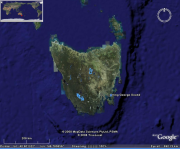SEAFLOOR TOPOGRAPHY
Type of resources
Topics
Keywords
Contact for the resource
Provided by
Years
-
Data from multibeam echosounder surveys taken as part of the Ningaloo Outlook project were classified into various seafloor cover types according to their hardness, rugosity and depth. The classifications were validated with towed video ground truth where it was available. This dataset describes two AOIs which are explicitly part of the Ningaloo Outlook Deep Reefs project. Substratum classifications were applied using multibeam backscatter angular response curves along with rugosity as input to a maximum likelihood classifier. See original metadata record(s) and associated attached documents for accuracy estimates, alternate classification techniques, and additional surveyed areas. https://doi.org/10.25919/kssa-5b46 https://doi.org/10.25919/kttc-x397 https://doi.org/10.25919/8m65-7k26
-
Raw acoustic data files for Tasmanian coastal waters from the LWM (Low water mark) to 40 metres in depth or 1.5 kms from shore.
-
Marine benthic habitat data for Tasmanian coastal waters from the LWM (Low water mark) to 40 metres in depth or 1.5 kms from shore. See 'Lineage' section of this record for full methodology and data dictionary. This data is also available via the Seamap Australia National Benthic Habitat Layer - a nationally consolidated benthic habitat map. https://metadata.imas.utas.edu.au/geonetwork/srv/eng/catalog.search#/metadata/4739e4b0-4dba-4ec5-b658-02c09f27ab9a
-

This study compared the individual and combined effects of two introduced marine species in SE Tasmania - the northern Pacific seastar (Asterias amurensis) and the European green crab (Carcinus maenas) - and investigated their impact on native invertebrate fauna using in situ caging experiments. Both species predate upon bivalves, and this study assessed the biological interaction between these introduced species and native bivalve species - allowing the impact of multiple exotic predator species to be investigated in one system. The cage experiments have 5 treatment groups, including all combinations of presence (single animal) and absence of seastars and crabs, and a control with neither. Predator activity (number and type of bivalves consumed) was recorded after 8 weeks by suction-sampling each cage and counting and identifying fauna.
-

This dataset is a mosaicked product of all publicly available bathymetry data within the Australian Exclusive Economic Zone (EEZ). The data package consists of 8x bathymetry mosaics (and associated bathymetry derivatives: hillshade, slope, aspect) for each of the 8x Parks Australia Management Effectiveness (ME) Depth Zones. The grid resolution of the mosaics has been guided by the depth gridding recommendations of the AusSeabed Australian Multibeam Guidelines (2020) to produce the following mosaics: • shallow zone (0-30m): 10m resolution • mesophotic zone (30-70m): 10m resolution • rariphotic zone (70-200m): 10m resolution • upper-slope zone (200-700m): 32m resolution • mid-slope zone (700-2,000m): 64m resolution • lower-slope zone (2,000-4,000m): 128m resolution • abyss zone (4,000-6,000m): 210m resolution • hadal zone (>6,000m): 210m resolution A systematic prioritisation approach was used to preferentially use newer, high-resolution, and cleaner bathymetry inputs from remote sensing (multibeam, singlebeam, satellite, seismic etc), with Digital Elevation Models (DEM) used as foundational data in regions where survey data was not available. This approach optimised spatial resolution by preserving higher resolutions in shallower waters as supported by the data, while also ensuring the output datasets remain manageable for downstream applications. The result is suite of depth-stratified bathymetry mosaics and associated derivatives that provide full coverage of Australia's marine estate (clipped to the boundaries of the Australian Exclusive Economic Zone (EEZ)). All publicly available bathymetry data as at February 2024 for was included. Data can be visualised and used in GIS packages as maps of hillshaded bathymetry and hillshaded slope at the following WMS endpoints: • bathymetry: https://geoserver.imas.utas.edu.au/geoserver/bathy_composites/AusEEZ_bathy_composite_multires/wms?request=GetCapabilities&service=WMS • slope: https://geoserver.imas.utas.edu.au/geoserver/bathy_composites/AusEEZ_bathy_slope_composite_multires/wms?request=GetCapabilities&service=WMS • aspect: https://geoserver.imas.utas.edu.au/geoserver/bathy_composites/AusEEZ_bathy_aspect_composite_multires/wms?request=GetCapabilities&service=WMS • aspect-slope (for mapping applications only): https://geoserver.imas.utas.edu.au/geoserver/bathy_composites/AusEEZ_bathy_aspectSlope_composite_multires/wms?request=GetCapabilities&service=WMS Data is available for download in the following packages (each structured as 8x mosaics for each ME Depth Zone at the gridding resolution specified above): (1) bathymetry composites; (2) hillshade composites; (3) slope composites; (4) aspect composites. An ancillary Shapefile footprint index file is also available showing the source data used in generating each region of the mosaics. Note that minimal cleaning of input data was conducted, and no attempt was made to smooth or blend the transitions between swath edges, or between swaths and the underlying DEMs. Consequently, noise and edge effects between adjacent input data may be visible. This should be considered when interpreting the data, and the data should not be used for navigational purposes. See the Lineage section of this record for full methodology.
 IMAS Metadata Catalogue
IMAS Metadata Catalogue